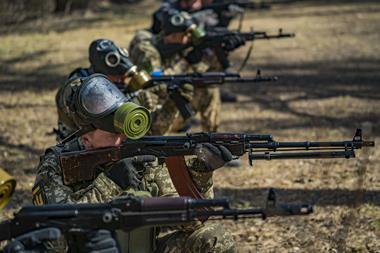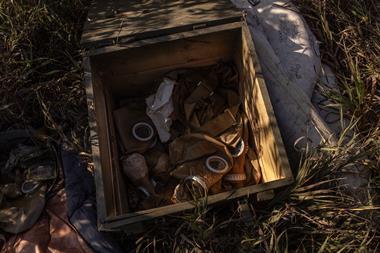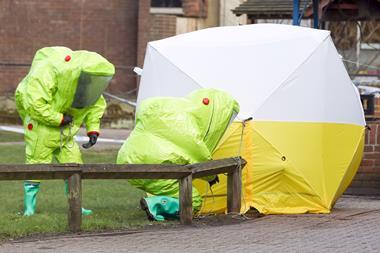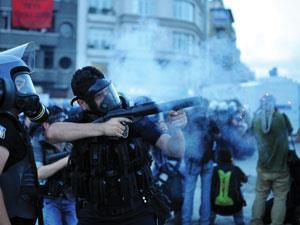On 1 May, the US Department of State announced that it had imposed new sanctions on the Russian Federation. These were in response to its ongoing war on Ukraine and use of chemical weapons in the country, including chloropicrin, a chemical belonging to Schedule 3 of the Chemical Weapons Convention, which was used as a tear gas in the first world war. The Department of State said it had ‘made a determination’ under the Chemical and Biological Weapons Control and Warfare Elimination Act of 1991, that Russia had used chloropicrin against Ukrainian forces in violation of the Chemical Weapons Convention.
But what exactly is tear gas?
It’s a generic term for a number of lachrymatory agents, used by law enforcement across the world to control riots and in some countries disrupt public protests. The name describes its effect – it causes severe eye and respiratory pain and causes tears to flow, leading to incapacitation. The most commonly used agent is CS gas, C10H5ClN2, a cyanocarbon compound 2-chlorobenzalmalononitrile. It is not in fact a gas but a white powder, generally used with a volatile solvent, such as methyl isobutyl ketone. When a cartridge is heated by a pyrotechnic charge it forms an aerosol of white smoke.
A handful of other compounds have been used over the years. In the 1950s CN gas (phenacyl chloride), commonly called Mace after an early manufacturer, was used in the US and sold as a self-defence spray. Another agent known as CR gas (dibenzoxazepine) was produced, but is now considered obsolete due to its poor safety record. Nevertheless, it still turns up around the world; there were reports that CR gas was used by Egyptian security forces in 2011; in 2013 in Venezuela, canisters of another obsolete agent, adamsite (diphenylaminechlorarsine), were used. Adamsite is known to give off toxic chloride and arsenic fumes when it degrades.
The US is accusing Russia of using another agent, chloropicrin, in its war on Ukraine. Discovered in 1848, chloropicrin is a synthetic C-nitro compound that appears as a slightly oily, colourless to yellow liquid. It is a severe irritant, and can cause immediate, severe inflammation of the eyes, nose and throat, and significant injuries to the upper and lower respiratory tract. Inhaling a large amount can also cause nausea and vomiting.
Chloropicrin was manufactured for use as a tear gas in the first world war but is now expressly banned under the Chemical Weapons Convention and is listed as a choking agent by the Organisation for the Prohibition of Chemical Weapons. It has been widely used in the US as a soil fumigant, particularly for strawberry crops and has a role as an insecticide, a nematicide and an antifungal agrochemical. It is not approved for use within the EU.
However, chemical weapons experts have expressed scepticism that Russia has used chloropicrin as the chemical is outdated as a weapon and the country is not thought to have stocked these munitions for decades. They note that other tear gas munitions, such as CN and CS gas may have been misidentified in the field due to the fact that chloropicrin is almost identical to CS in terms of its symptoms and odour.
So who came up with the idea and how was it developed?
It started in the first world war. In August 1914, French forces fired tear-gas grenades made from xylyl bromide or ethyl bromoacetate into German trenches. But the approach was hard to make work and never very effective. Of course, the first world war is now better known for the use of far more lethal gases, such as chlorine, bromine, phosgene and mustard gas.
CS gas was first synthesised by US chemists Ben Corson and Roger Stoughton at Middlebury College in Vermont in 1928, while investigating the reaction between carbonyl compounds and malononitrile. The reaction is catalysed with a weak base in a modified aldol condensation and the production method has predominantly stayed the same since. Corson and Stoughton, who created its name from their own surnames, noted that the white powder was ‘harmless when wet, but to handle the dry powder is disastrous’. Their discovery remained inconsequential for another 35 years, until it became widely used by the US military during the Vietnam War.
In the 1950s and 1960s CS was secretly tested at the UK’s Defence Science and Technology Laboratory in Porton Down, Wiltshire, on animals and British Army servicemen volunteers and proved to be far more benign than the nerve gas Venomous Agent X, also being developed there at the same time.
What do we know about its short and long-term effects?
Compounds such as CS gas target the TRPA1 nervous system receptor, which is part of our pain signalling circuitry. Its stimulation causes a burning sensation and leads to the lacrimal gland producing excess tears and nasal mucus discharge. The effects can ultimately lead to disorientation and even difficulty breathing.
While it is generally accepted to be non-lethal, a 2016 review by Physicians for Human Rights identified two deaths from 31 studies, which included 5131 people who had been injured by these crowd control chemicals. One death was caused by respiratory problems, the other by being hit by the canister itself. They also reported 70 cases of permanent disability, including blindness. There were reports of several deaths from 2011 demonstrations in both Egypt and Bahrain. From Turkish civil disturbances in 2013, there is also evidence that the respiratory effects are more serious for women.

A UK Department of Health report from 1999 stated that there were reasons to be concerned that tear gas could be dangerous to those with respiratory conditions or cardiovascular disease. There have been no concerns relating to issues such as carcinogenicity, although little work has been done on the longer-term effect of exposure to CS gas. Animal tests from the 1950s and 60s suggested its long-term toxicity was low, but a US Army study in 2014 found that long-term exposure to CS gas caused lung injuries in their recruits.
Who makes it and how is it regulated?
The horrors of gas attacks in the first world war dampened most countries’ appetite for chemical weapons and so its use is prohibited in war under the terms of the 1993 Chemical Weapons Convention, even though its effects are clearly not comparable to other chemical weapons. But the Chemical Weapons Convention doesn’t cover domestic use and there is no general ban on producing or stockpiling tear gas in the UK. It can’t be imported or possessed for personal defence though.
While CS gas canisters are rarely deployed on the British mainland – the exception being the 1981 riots in the Toxteth area of Liverpool – CS hand-held sprays were introduced in 1996 and are now used routinely by the police. They contain a 5% solution of CS dissolved in methyl isobutyl ketone and propelled by pressurised nitrogen.
Several chemical companies have been criticised for supplying tear gas to regimes with poor human rights records. In 2011 Rio de Janeiro-based firm Condor Non-Lethal Technologies supplied tear gas used in Bahrain, which was reported to have led to the deaths of two young children. In the publicity surrounding the event, the corporation claimed that the Bahraini authorities had failed to follow their instructions for proper use.
Tear gas used against pro-democracy demonstrators in Egypt in 2011 was traced back to Chemring, a British weapons manufacturer, whose canisters also appeared in Hong Kong in 2014. The bad publicity surrounding this may have had an impact, with the Chemring Group announcing in June 2019 the sale of its UK arm and its exit from manufacturing or distributing CS gas. In the same month, following further use of CS gas against demonstrators in Hong Kong, the UK government banned sales to the region altogether.
Additional reporting by Julia Robinson.












No comments yet